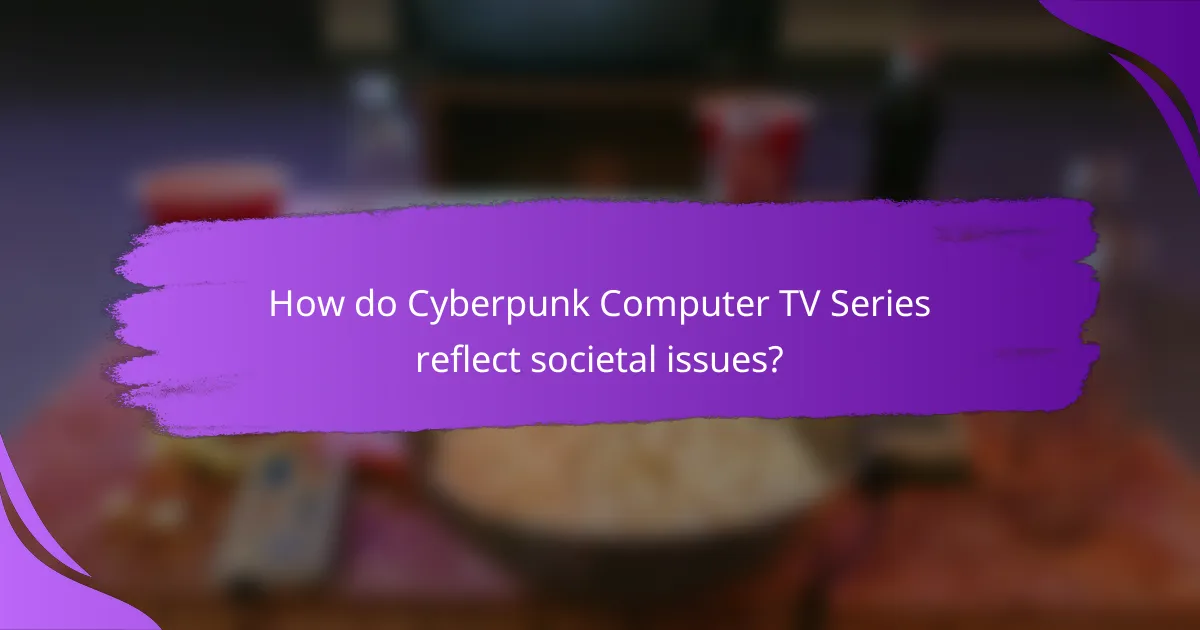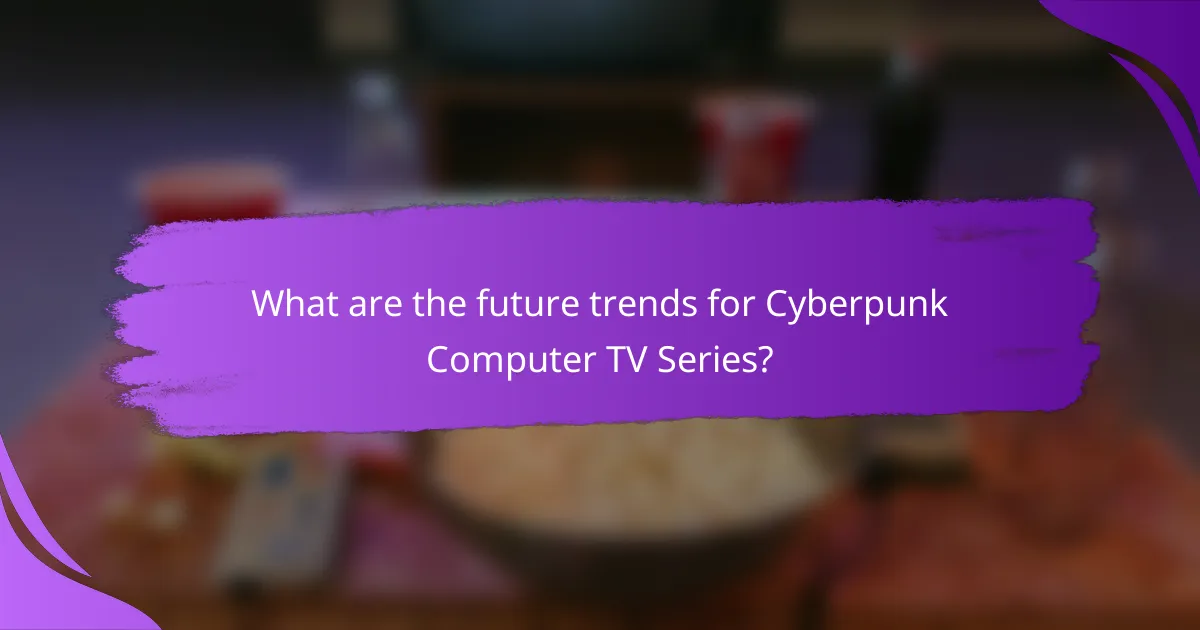Cyberpunk Computer TV Series are characterized by futuristic settings, advanced technology, and dystopian themes that reflect societal issues. These series often feature anti-heroes confronting corrupt corporations and oppressive governments, with narratives that explore identity, surveillance, and the human condition. Notable examples include “Altered Carbon” and “Ghost in the Shell,” which illustrate the impact of technology and capitalism on social inequality and individuality. Future trends in this genre include increased integration of virtual reality, interactive storytelling, and AI-generated content, alongside evolving visual aesthetics and a heightened focus on contemporary societal themes.

What defines Cyberpunk Computer TV Series?
Cyberpunk Computer TV Series are defined by their futuristic settings, advanced technology, and dystopian themes. They often explore the impact of cybernetics, artificial intelligence, and virtual reality on society. These series typically feature anti-heroes navigating corrupt corporations and oppressive governments. Aesthetic elements include neon lights, urban landscapes, and a blend of high-tech and low-life environments. Storylines frequently delve into issues of identity, surveillance, and the human condition in a tech-dominated world. Notable examples include “Altered Carbon” and “Ghost in the Shell,” which exemplify these characteristics through complex narratives and rich visual styles.
How do aesthetics play a role in Cyberpunk Computer TV Series?
Aesthetics play a crucial role in Cyberpunk Computer TV Series by creating immersive worlds. These series often feature neon lighting, urban decay, and high-tech elements. The visual style reflects themes of dystopia and technological advancement. Iconic examples include “Blade Runner: Black Lotus” and “Altered Carbon.” The use of contrasting colors enhances the narrative’s emotional depth. Aesthetics influence character design and environment, shaping viewer perception. The distinct look sets a tone that resonates with cyberpunk literature and art. This visual language reinforces the genre’s exploration of identity and society.
What visual elements are characteristic of the cyberpunk aesthetic?
The cyberpunk aesthetic is characterized by a blend of high-tech and low-life visual elements. Neon lights dominate urban landscapes, creating a vibrant yet gritty atmosphere. Dark, moody color palettes are often employed, emphasizing contrasts between light and shadow. Futuristic architecture features prominently, with towering skyscrapers and sprawling megacities. Technology is visibly integrated into everyday life, often showcased through cybernetic enhancements and digital displays. Rain-soaked streets and urban decay contribute to a dystopian feel. Additionally, fashion in cyberpunk includes edgy, eclectic styles, often with a mix of punk and futuristic influences. This aesthetic reflects themes of societal collapse and the fusion of humanity with technology.
How does color palette influence the mood in these series?
Color palette significantly influences the mood in cyberpunk series. Dark, neon colors often create a sense of dystopia and tension. Bright colors can evoke feelings of hope or energy. The contrast between light and dark shades enhances emotional depth. For example, the use of blue tones may suggest coldness or technology. In contrast, warm colors might indicate humanity or warmth. Studies show that color psychology affects viewer perception and emotional response. Thus, the chosen color palette shapes audience engagement and interpretation.
What are the common storylines found in Cyberpunk Computer TV Series?
Common storylines in Cyberpunk Computer TV Series often revolve around dystopian futures. These narratives typically explore themes of corporate control and societal decay. Many series depict protagonists fighting against oppressive systems. Cybernetic enhancements and artificial intelligence play significant roles in character development. Conflicts often arise between human identity and technological integration. Additionally, stories frequently feature rogue hackers and underground resistance movements. The exploration of virtual realities and digital consciousness is also prevalent. Overall, these storylines reflect concerns about technology’s impact on humanity.
How do themes of technology and society interplay in these narratives?
Themes of technology and society deeply intertwine in cyberpunk narratives. These stories often depict advanced technology’s impact on social structures. They showcase how technology shapes human experiences and relationships. For instance, in series like “Altered Carbon,” society is divided by access to technology. The wealthy can transfer their consciousness, while the poor remain marginalized. This disparity highlights social inequality exacerbated by technological advancements. Additionally, these narratives often explore dystopian outcomes of unchecked technological growth. They serve as cautionary tales about the potential consequences of a tech-driven society. Overall, cyberpunk reflects the complex dynamics between innovation and societal change.
What role do dystopian futures play in shaping the plots?
Dystopian futures serve as critical backdrops that influence plot development in cyberpunk narratives. They establish a setting characterized by societal collapse, oppressive regimes, and advanced technology. These futures create conflict by highlighting struggles between individuals and authoritarian systems. Characters often navigate moral dilemmas shaped by their bleak environments. The atmosphere of despair drives character motivations and actions. For instance, in “Blade Runner,” the dystopian setting prompts questions about humanity and identity. Thus, dystopian futures are essential in shaping character arcs and thematic explorations within plots.
What cultural influences are evident in Cyberpunk Computer TV Series?
Cyberpunk Computer TV Series exhibit influences from various cultures, particularly Asian and Western elements. The aesthetic often draws from Japanese cyberpunk, showcasing neon-lit cityscapes and advanced technology. Storylines frequently explore themes of corporate control, reflecting concerns from Western societies about capitalism. The blending of Eastern philosophies, such as Buddhism, with Western dystopian narratives is also evident. Additionally, fashion and character design often incorporate streetwear trends from urban cultures globally. The series often critiques social issues, influenced by global movements for equality and justice. Cultural symbolism is prevalent, with references to mythology and folklore from diverse backgrounds. This fusion creates a rich tapestry that resonates with a wide audience.
How does literature shape the storytelling in these series?
Literature shapes storytelling in cyberpunk series by providing foundational themes and narrative structures. Influential works like William Gibson’s “Neuromancer” establish core concepts such as virtual realities and dystopian futures. These themes are echoed in series like “Altered Carbon,” which explores identity and consciousness. Literary elements such as character development and world-building enhance the viewer’s immersion. The use of metaphors and symbolism from literature enriches the narrative depth. Additionally, literary influences guide the moral and ethical questions posed in the series. This connection to literature creates a layered storytelling experience that resonates with audiences.
What impact do video games have on the development of cyberpunk narratives?
Video games significantly influence the development of cyberpunk narratives. They introduce interactive elements that enhance storytelling. Players engage with complex worlds that reflect dystopian futures. This interactivity allows for deeper immersion in cyberpunk themes. Games like “Deus Ex” and “Cyberpunk 2077” showcase advanced technology and societal decay. These titles incorporate rich lore and character development. They often explore themes of identity and humanity’s relationship with technology. The narrative depth in video games complements traditional cyberpunk literature and film. This synergy shapes a more dynamic and engaging cyberpunk experience.

How do Cyberpunk Computer TV Series reflect societal issues?
Cyberpunk computer TV series reflect societal issues by portraying dystopian futures influenced by technology and capitalism. These narratives often highlight themes like social inequality, corporate control, and loss of individuality. For instance, series like “Altered Carbon” showcase a society where wealth dictates access to immortality, emphasizing class disparities. Additionally, “Black Mirror” explores the dark sides of technological advancement, illustrating potential societal consequences. The visual aesthetics often depict urban decay and surveillance, representing fears of a loss of privacy. Overall, these series serve as cautionary tales, prompting viewers to consider the implications of current technological trends on society.
What social themes are commonly explored in these series?
Common social themes in cyberpunk computer TV series include dystopia, technology’s impact on society, and class struggle. These series often depict a future where societal norms are challenged. They explore the consequences of technological advancement on human relationships and individuality. Issues of surveillance and privacy are frequently highlighted. Many narratives focus on corporate greed and its effect on the lower classes. Themes of identity and transhumanism are also prevalent. The portrayal of marginalized communities is a recurring aspect. Additionally, environmental degradation often serves as a backdrop for these stories.
How is the concept of identity portrayed in cyberpunk narratives?
The concept of identity in cyberpunk narratives is often portrayed as fragmented and fluid. Characters frequently navigate complex realities where their physical forms and digital personas can diverge. This duality raises questions about authenticity and self-perception. The integration of technology into human life complicates traditional notions of identity. For example, characters may undergo body modifications or upload their consciousness into virtual spaces. This leads to existential dilemmas regarding what it means to be human. Prominent works, such as “Neuromancer” by William Gibson, highlight these themes. In this novel, the protagonist’s identity is shaped by both cybernetic enhancements and virtual experiences. Overall, cyberpunk explores how technology reshapes personal identity in profound ways.
What commentary do these series provide on capitalism and consumerism?
Cyberpunk computer TV series critique capitalism and consumerism by depicting dystopian futures. These narratives often showcase extreme wealth disparity and corporate dominance. Characters frequently navigate oppressive systems controlled by powerful entities. The portrayal of consumer culture emphasizes superficiality and materialism. For instance, characters often rely on technology for identity and status. This reflects a society where human connection is diminished by commercial interests. The series highlight the consequences of unchecked capitalism, such as environmental degradation and social alienation. By illustrating these themes, they provoke critical discussions about the implications of current economic systems.
How do characters in Cyberpunk Computer TV Series represent various archetypes?
Characters in Cyberpunk Computer TV Series embody various archetypes such as the anti-hero, the hacker, and the corporate villain. The anti-hero often struggles with moral ambiguity, reflecting the chaotic nature of the cyberpunk world. The hacker archetype represents rebellion against authority and the quest for freedom through technology. Corporate villains typically symbolize greed and the dangers of unchecked capitalism. These archetypes serve to critique societal issues like surveillance, corporate power, and identity in a high-tech future. For example, in “Altered Carbon,” the protagonist, Takeshi Kovacs, exemplifies the anti-hero archetype through his complex motivations and ethical dilemmas. This representation allows viewers to engage with deeper themes within the narrative.
What are the common character types found in these narratives?
Common character types in cyberpunk narratives include hackers, corporate agents, and rebels. Hackers often possess advanced technical skills, navigating digital landscapes to achieve their goals. Corporate agents typically represent powerful entities, enforcing corporate interests and maintaining control. Rebels challenge the status quo, fighting against oppressive systems and advocating for change. Additionally, artificial intelligences and cyborgs frequently appear, blurring the line between human and machine. These character types reflect the genre’s themes of technology, power, and societal conflict.
How do protagonists and antagonists embody the themes of the genre?
Protagonists and antagonists in cyberpunk TV series embody the genre’s themes through their conflict and moral ambiguity. Protagonists often represent the struggle against oppressive systems, showcasing resilience and individuality. They navigate dystopian environments, highlighting themes of identity and technology’s impact on humanity. Antagonists typically embody the corrupt forces of authority or corporate greed. Their motivations often reflect the dehumanizing effects of technology and capitalism. This dynamic illustrates the tension between personal freedom and societal control. For example, in “Altered Carbon,” the protagonist fights against a system that commodifies human consciousness. This conflict exemplifies the core themes of cyberpunk, such as existentialism and the questioning of reality.

What are the future trends for Cyberpunk Computer TV Series?
Future trends for Cyberpunk Computer TV Series include increased integration of virtual reality. This technology enhances viewer immersion in the narrative. Interactive storytelling is also expected to rise. Viewers may influence plot outcomes through their choices. Additionally, AI-generated content could play a significant role. This innovation allows for dynamic storylines tailored to individual preferences. The aesthetic will likely evolve with advancements in CGI. More realistic visuals will enhance the cyberpunk atmosphere. Finally, themes addressing societal issues will gain prominence. These themes will resonate with contemporary audiences, reflecting real-world concerns.
How is technology evolving within the context of cyberpunk narratives?
Technology in cyberpunk narratives evolves to reflect societal concerns and advancements. It often showcases advanced cybernetics, artificial intelligence, and virtual realities. These elements illustrate the fusion of humanity with machines. The narratives typically depict a dystopian future where technology exacerbates social inequalities. Innovations in biotechnology and surveillance are common themes. For instance, characters may enhance themselves with cybernetic implants. This evolution raises ethical questions about identity and autonomy. The portrayal of mega-corporations controlling technology reflects real-world anxieties about corporate power. Overall, technology in cyberpunk serves as both a tool and a symbol of societal issues.
What role will artificial intelligence play in future series?
Artificial intelligence will play a significant role in future series by enhancing storytelling and character development. AI can generate complex narratives and create dynamic characters that evolve based on viewer interactions. This technology allows for personalized viewing experiences, tailoring content to individual preferences. Additionally, AI can analyze audience reactions in real-time, informing future episodes and series directions. The integration of AI in series production can streamline workflows, making the creation process more efficient. As AI technology advances, its capabilities in generating visual effects and sound design will also improve, elevating the overall production quality. According to a report by PwC, AI is expected to contribute $15.7 trillion to the global economy by 2030, indicating its growing influence across industries, including entertainment.
How might advancements in virtual reality influence storytelling?
Advancements in virtual reality (VR) significantly influence storytelling by creating immersive experiences. VR allows users to engage with narratives in a three-dimensional space. This technology enhances emotional connection through interactive elements. Users can explore environments and make choices that affect outcomes. Studies show that immersive storytelling increases retention and empathy among audiences. For example, VR experiences like “The Invisible Man” have demonstrated heightened emotional responses. Additionally, VR can incorporate real-time feedback, making narratives more dynamic. As VR technology evolves, storytelling will likely become more participatory and personalized.
What best practices can creators follow when developing Cyberpunk Computer TV Series?
Creators developing Cyberpunk Computer TV Series should focus on world-building. Establish a detailed and immersive setting that reflects dystopian themes. Integrate advanced technology and its societal impact into the narrative. Characters must be complex, embodying the struggles of a cyberpunk society. Strong visual aesthetics should align with the genre’s signature style, featuring neon lights and urban decay. Collaborating with experts in technology can enhance authenticity. Engaging storylines should explore themes of identity, control, and resistance. Researching existing cyberpunk literature and media can provide valuable insights. These practices ensure a compelling and authentic representation of the cyberpunk genre.
How can creators balance aesthetics and narrative effectively?
Creators can balance aesthetics and narrative effectively by integrating visual elements that enhance storytelling. This involves using color schemes, lighting, and composition to reflect the themes of the narrative. For instance, in cyberpunk series, neon colors often symbolize technological advancement and societal decay. Additionally, character design should align with their development arcs, visually representing their journeys.
Incorporating sound design also plays a crucial role. Soundtracks can evoke emotions that complement visual storytelling. This synergy between visuals and audio deepens audience engagement. Furthermore, pacing is essential; creators must ensure that aesthetic sequences do not overshadow narrative progression.
Research shows that successful series, like “Blade Runner: Black Lotus,” achieve this balance through meticulous planning. They create a cohesive world where aesthetics serve the story rather than distract from it. By prioritizing this integration, creators can craft immersive experiences that resonate with viewers.
What strategies can be employed to engage audiences in cyberpunk themes?
Utilizing immersive storytelling is a key strategy to engage audiences in cyberpunk themes. This involves creating complex narratives that explore dystopian futures and technological advancements. Engaging characters with relatable struggles enhance audience connection. Visual aesthetics play a significant role; neon lights and urban landscapes evoke the cyberpunk atmosphere. Interactive media, such as video games, allows audiences to experience the world firsthand. Social media campaigns can build community and discussion around themes, fostering deeper engagement. Additionally, incorporating real-world technological trends makes the themes more relatable and thought-provoking. Historical context, such as the rise of the internet in the 1990s, provides a foundation for narrative authenticity.
Cyberpunk Computer TV Series are characterized by their futuristic settings, advanced technology, and dystopian themes, exploring the impact of cybernetics and artificial intelligence on society. The article examines the significant role of aesthetics, including neon lighting and urban landscapes, in creating immersive worlds that reflect complex narratives. It discusses common storylines that delve into themes of corporate control, identity, and societal decay, while also highlighting cultural influences and character archetypes prevalent in the genre. Additionally, the piece addresses the future trends in cyberpunk narratives, focusing on advancements in technology, virtual reality, and audience engagement strategies.